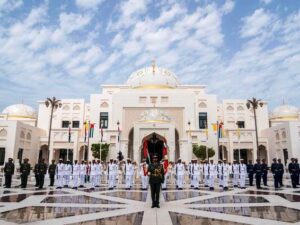» posted on Monday, August 8th, 2022 by Linda Lou Burton
Things Are Looking Up
Originally published August 6, 2020 by Linda Lou Burton posting about Abu Dhabi, United Arab Emirates from Little Rock, Arkansas – I love saying Abu Dhabi out loud. What a great sound it has! Its meaning is pretty too, “Abu” is Arabic for father, and “Dhabi” is the Arabic word for gazelle. Abu Dhabi – 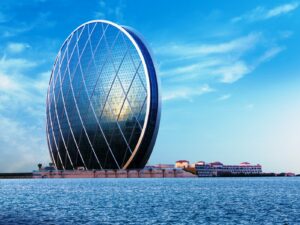 Father of Gazelle. It is thought this name came about because of the abundance of gazelles in the area. Those gazelles have long since been replaced by people – the population has grown in the last 60 years from 25,000 to 1.5 million! And skyscrapers you would not believe. Some of the tallest buildings on the skyline include the 1,253 ft Central Market Residential Tower, the 1,063 ft Landmark, and the 74-story 1,017 ft Sky Tower. And not just tall, but unique, the Aldar Headquarters was the first circular skyscraper in the Middle East. Because of its coin shape, it is called the Dirham building, after the Emirati currency.
Father of Gazelle. It is thought this name came about because of the abundance of gazelles in the area. Those gazelles have long since been replaced by people – the population has grown in the last 60 years from 25,000 to 1.5 million! And skyscrapers you would not believe. Some of the tallest buildings on the skyline include the 1,253 ft Central Market Residential Tower, the 1,063 ft Landmark, and the 74-story 1,017 ft Sky Tower. And not just tall, but unique, the Aldar Headquarters was the first circular skyscraper in the Middle East. Because of its coin shape, it is called the Dirham building, after the Emirati currency.
Abu Dhabi’s rapid development and urbanization, coupled with its massive oil and gas reserves and relatively high average income, have transformed it into a large, developed metropolis. It is the capital and the second-most populous city of the United Arab Emirates (after Dubai), and accounts for about two-thirds of the $400 billion UAE economy. Abu Dhabi sits on an island in the Persian Gulf, though most of the city and the Emirate reside on 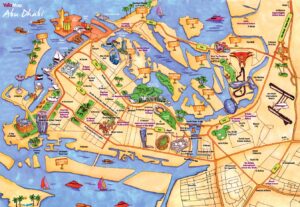 the mainland connected to the rest of the country. I’m one of the lucky ones waking up on the island this morning. My hotel, the Marriott St Regis, is another one of the “tall unusual”
the mainland connected to the rest of the country. I’m one of the lucky ones waking up on the island this morning. My hotel, the Marriott St Regis, is another one of the “tall unusual” 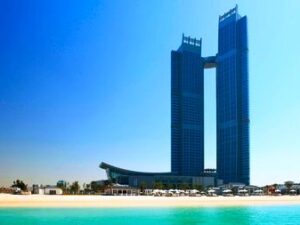 buildings in Abu Dhabi, and I have never been so close to luxury’s lap. See the “connector” between the two towers? That is the 3-bedroom private suite with its own elevator to the 46th floor and a view to die for. That’s not my room, (chuckle, I left my
buildings in Abu Dhabi, and I have never been so close to luxury’s lap. See the “connector” between the two towers? That is the 3-bedroom private suite with its own elevator to the 46th floor and a view to die for. That’s not my room, (chuckle, I left my 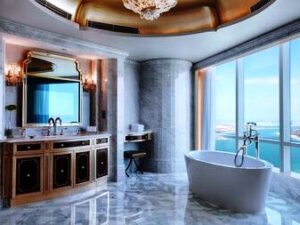 helicopter back home), but my view is pretty darn spectacular, looking out over the Persian Gulf; for pete’s sake, just look at my bathroom!
helicopter back home), but my view is pretty darn spectacular, looking out over the Persian Gulf; for pete’s sake, just look at my bathroom!
I’d stay right here at this hotel all day long, except, I am dying to see the skyscrapers here, and I have to visit the Presidential Palace. It’s just down the street, and as of last year, is open for public visits. It is called “Qaṣr Al-Waṭan” in Arabic, meaning “Palace of the Nation” and is ranked among the top 20 landmarks of art and culture in the world. It could be called “The White House” – its façade is white granite and limestone, intricately designed and ornately decorated. It includes a dome with a diameter of 121 ft, and a  chandelier with 350,000 pieces of crystal. The dome is located on top of the central chamber known as “The Great Hall,” which is surrounded by two wings to the east and west.
chandelier with 350,000 pieces of crystal. The dome is located on top of the central chamber known as “The Great Hall,” which is surrounded by two wings to the east and west.
The eastern wing has the “House of Knowledge,” where a number of artifacts and other objects of importance are stored, such as gifts presented by visiting officials from other countries, religious texts (the Quran and the Bible), and a library with more than 50,000 books which document the cultural, social and political history of the country. The western wing is used for official purposes. Meetings of the UAE Cabinet and Federal Supreme Council, and summits of international bodies like the Organisation of the Islamic Conference, Arab League, and Gulf Cooperation Council are held here in a room known as the “Spirit of Collaboration.”
I’m going to point out just a few more skyscrapers; the Etihad Towers are near the Palace; five towers keeping company, do they look like swaying grass or trees against the skyline to you? Two of the towers are connected by a walkway on the 75th floor.
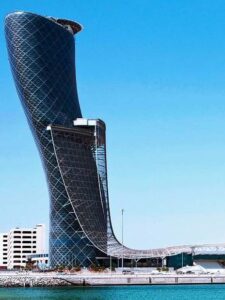 The Capital Gate, just on down the road a way, is referred to as the “Leaning Tower of Abu Dhabi,” and holds the Guinness World Record for the “world’s furthest-leaning man-made tower.” Completed in 2011, it is also the Middle East’s first building to use a material-saving diagrid form.
The Capital Gate, just on down the road a way, is referred to as the “Leaning Tower of Abu Dhabi,” and holds the Guinness World Record for the “world’s furthest-leaning man-made tower.” Completed in 2011, it is also the Middle East’s first building to use a material-saving diagrid form.
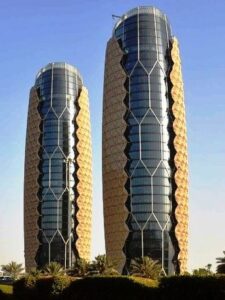 And when it comes to design, look at the twin, 29-story Al Bahr Towers riff on the traditional Arabian mashrabiya (geometric window coverings) as an ingenious energy-saving measure; the windows react automatically to the sun, expanding to provide shade and reduce the need for air conditioning. This one was completed in 2013.
And when it comes to design, look at the twin, 29-story Al Bahr Towers riff on the traditional Arabian mashrabiya (geometric window coverings) as an ingenious energy-saving measure; the windows react automatically to the sun, expanding to provide shade and reduce the need for air conditioning. This one was completed in 2013.
I’ll tell you what I discover about the food, and the other sights I see in a later post. Right now I’m a little dizzy from all that looking up.

